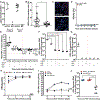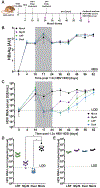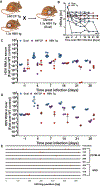Preclinical assessment of antiviral combination therapy in a genetically humanized mouse model for hepatitis delta virus infection
- PMID: 29950446
- PMCID: PMC6337727
- DOI: 10.1126/scitranslmed.aap9328
Preclinical assessment of antiviral combination therapy in a genetically humanized mouse model for hepatitis delta virus infection
Abstract
Chronic delta hepatitis, caused by hepatitis delta virus (HDV), is the most severe form of viral hepatitis, affecting at least 20 million hepatitis B virus (HBV)-infected patients worldwide. HDV/HBV co- or superinfections are major drivers for hepatocarcinogenesis. Antiviral treatments exist only for HBV and can only suppress but not cure infection. Development of more effective therapies has been impeded by the scarcity of suitable small-animal models. We created a transgenic (tg) mouse model for HDV expressing the functional receptor for HBV and HDV, the human sodium taurocholate cotransporting peptide NTCP. Both HBV and HDV entered hepatocytes in these mice in a glycoprotein-dependent manner, but one or more postentry blocks prevented HBV replication. In contrast, HDV persistently infected hNTCP tg mice coexpressing the HBV envelope, consistent with HDV dependency on the HBV surface antigen (HBsAg) for packaging and spread. In immunocompromised mice lacking functional B, T, and natural killer cells, viremia lasted at least 80 days but resolved within 14 days in immunocompetent animals, demonstrating that lymphocytes are critical for controlling HDV infection. Although acute HDV infection did not cause overt liver damage in this model, cell-intrinsic and cellular innate immune responses were induced. We further demonstrated that single and dual treatment with myrcludex B and lonafarnib efficiently suppressed viremia but failed to cure HDV infection at the doses tested. This small-animal model with inheritable susceptibility to HDV opens opportunities for studying viral pathogenesis and immune responses and for testing novel HDV therapeutics.
Copyright © 2018 The Authors, some rights reserved; exclusive licensee American Association for the Advancement of Science. No claim to original U.S. Government Works.
Conflict of interest statement
Figures






References
Publication types
MeSH terms
Substances
Grants and funding
- P30 CA016087/CA/NCI NIH HHS/United States
- P30 CA072720/CA/NCI NIH HHS/United States
- R01 AI138797/AI/NIAID NIH HHS/United States
- P30 CA034196/CA/NCI NIH HHS/United States
- S10 OD018338/OD/NIH HHS/United States
- R01 AI079031/AI/NIAID NIH HHS/United States
- R21 AI117213/AI/NIAID NIH HHS/United States
- F31 AI122480/AI/NIAID NIH HHS/United States
- T32 GM007388/GM/NIGMS NIH HHS/United States
- R03 DK117252/DK/NIDDK NIH HHS/United States
- R21 AI106000/AI/NIAID NIH HHS/United States
- K08 DK101754/DK/NIDDK NIH HHS/United States
- R01 AI107301/AI/NIAID NIH HHS/United States
LinkOut - more resources
Full Text Sources
Other Literature Sources
Molecular Biology Databases
Miscellaneous

